|
The 2013 Zoos and Aquariums: Committing to Conservation (ZACC) conference runs from July 8th—July 12th in Des Moines, Iowa, hosted by the Blank Park Zoo. Ahead of the event, Mongabay.com is running a series of Q&As with presenters. For more interviews, please see our ZACC feed. |

Forest bromeliad treefrog (Osteocephalus cabrerai). Photo by: Marcy Sieggreen.
According to the International Union for Conservation of Nature, amphibians are the most threatened group of animals on Earth: currently around 30 percent of the world’s amphibians are listed as threatened with extinction. However this percentage doesn’t include those species about which too little is known to evaluate (26 percent). Amphibians face many threats but two of the largest are habitat loss and the lethal chytrid fungus, which has rapidly spread worldwide and is likely responsible for numerous extinctions. But conservationists are coming up with innovative and creative ways to keep amphibians from disappearing, including a program from the Detroit Zoological Society (DZS) that is working with students in the Peruvian Amazon to monitor frog populations.
“What we were interested in learning [from the students] was very basic information: what types of amphibians were they seeing, time of day, time of year, dates, where they found them, condition, numbers. We had several thoughts about this. If they understood and could appreciate what they have, there would be an interest in protecting it. Since visits from us occurred only twice a year, we needed help to identify any significant changes or finds that may be of interest that we would have missed,” explains Marcy Sieggreen, who heads up the Amazon Amphibian Protectors Club, in a recent interview with mongabay.com.
Sieggreen says that logging is likely the largest threat to amphibians in the area. However, her and colleagues have also discovered the presence of chytrid fungus in the region.
“Approximately 400 samples have been taken and fewer than 30 had positive results. Our work with amphibians in the area has been going on for about four years, but information is data-deficient to actually assess the current situation,” she notes, adding that at least to date the disease doesn’t seem widespread. “Frequently we see amphibians that we would expect to see, rarely find dead or sickly animals, and have only received positive results for disease in a small number of species.”
Working with local students not only helps monitor the frog populations, but also leads to better conservation awareness among local populations that have long feared amphibians due to the mistaken belief that they caused skin problems.
Marcy Sieggreen will be presenting on her work with the Amazon Amphibian Protectors Club at the 2013 Zoos and Aquariums: Committing to Conservation (ZACC) conference on Thursday, July 11th in Des Moines, Iowa.
AN INTERVIEW WITH MARCY SIEGGREEN
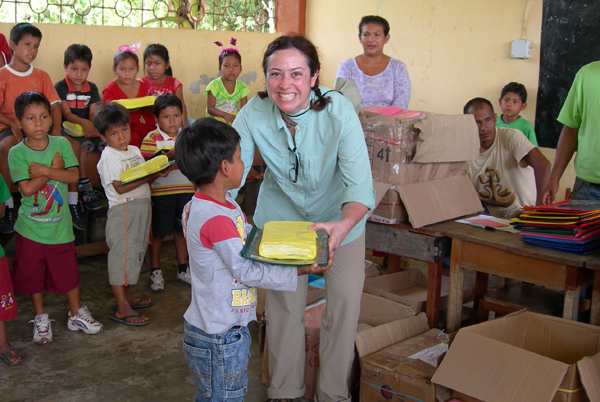
Marcy Sieggreen with Adopt-A-School kids in Peru. Photo courtesy of Marcy Sieggreen.
Mongabay: What’s your background?
Marcy Sieggreen: I have two bachelor of science degrees from Eastern Michigan University, one in Aquatic and Terrestrial Ecosystems in Biology, with a double major in Geography and minors in Conservation and Resource and Group Science. The other is in Earth Science. My master’s degree is in Biological Sciences from Wayne State University. I am currently working on my Ph.D. in Environmental Science at Antioch University in New Hampshire.
While working on my undergraduate degrees, I enrolled in every field course and internship opportunity that was available at the Detroit Zoological Society (DZS). Upon completion of my first internship, I stayed as a seasonal employee for several more months during the opening of the Wildlife Interpretive Gallery and photographed animals throughout the Detroit Zoo. I began working as the Curator of Amphibians in the National Amphibian Conservation Center for the Detroit Zoological Society in 2008.
Mongabay: What drew you to amphibians?
Marcy Sieggreen: Do you mean aside from how lovely they are and that almost all of them have a permanent smile?! Really though, they are fascinating in so many ways. They are a perfect example of an evolutionary species that has survived despite all of the environmental changes and within the species have shown every reproductive strategy known. I grew up with an interest and appreciation for herpetology. I don’t think I was drawn to them, I think it was always there.
Mongabay: How did you end up working in the Peruvian rainforest?

Young juvenile variable clown frog (Hyla triangulum). Photo by: Marcy Sieggreen.
Marcy Sieggreen: For decades the Detroit Zoo has had several ongoing projects in the lower elevations of the Napo and Amazon River basins. With amphibian concerns growing around the world and having a large presence in this area, it made sense to develop a project that identifies species and monitors population sizes.
Mongabay: What are the threats to amphibians here?
Marcy Sieggreen: I would have to say that deforestation from logging could quite possibly pose the biggest threat in this area. Up and down the Amazon and Napo Rivers, several acres of land have already succumbed to this type of devastation and the lack of trees in an otherwise dense rainforest is a brutal reality. Cut trees fill up the sides of the river waiting for logging ships to pick them up while pathways along the river narrow during high water with the abundance of debris from unwanted trees.
We have positive tests for chytrid Bd, however we have really just begun data collection and would be speculating as to the threat of this disease.
Mongabay: What were some of the misconceptions regarding amphibians among locals in Peru?

Students with the Amazon Amphibian Protectors Club. Photo by: Marcy Sieggreen.
Marcy Sieggreen: Most of what we heard and saw was a fear of zoonotic diseases, specifically warts. Parents would have buckets of toads and frogs piled together that they would remove or destroy. When asked why they had them in buckets, kids would show us their arms or parents would motion to have their children come over so we could see how their hands and arms were covered in what appeared to be warts. Not being in the medical field, I did my best to explain transmission and convince them that the toads did not give them warts, which seemed to satisfy their concerns. The communities were very receptive to having discussions about the benefits and roles amphibians play. They just needed to know that these buckets of toads were not a nuisance and they were a productive part of the food chain that would contribute to diminishing some of the pests that annoy them.
Mongabay: Will you tell us about the Amazon Amphibian Protectors Club? How are these local students protecting amphibians?
Marcy Sieggreen: The previous work and relationships developed by DZS with the Adopt-A-School program and conservation projects allowed us to expand projects to include work with amphibians. I had the opportunity to spend time with our education team while they were delivering supplies to schools along the Amazon and Napo River basins. During introductions with the students, I was able to give a brief talk. Kids and instructors showed so much interest that it was evident we should be capitalizing on that enthusiasm and provide more education for them. The school systems along the rivers are not anything like I had ever experienced and locating a school to start a pilot program was difficult. High water flooded some areas, and villages sent their kids to other communities or chose to have their children work rather than go to school. Eventually a stable school was found and, after presentations and several visits, we had support from the principal, two professors and a group of 15 kids.
The group of secondary students ranged in age from 12 to 16. They had a very strong interest in learning more about amphibians. What we were interested in learning was very basic information: what types of amphibians were they seeing, time of day, time of year, dates, where they found them, condition, numbers. We had several thoughts about this. If they understood and could appreciate what they have, there would be an interest in protecting it. Since visits from us occurred only twice a year, we needed help to identify any significant changes or finds that may be of interest that we would have missed.
During this process the students write stories and reports which they present in class. We anticipate their interest and desire may create interest from their peers. We have turned the image of amphibians around for them. Our experiential education for them has opened their eyes to the importance of amphibians. One child told us he couldn’t wait to see more and that he wanted to keep looking, but his mother said he needed to go to bed. Two additional communities have been added to our program and in November we will return to note their progress.
Mongabay: Over the last few years what have the tests for chytrid fungus shown?

Logging boat. Photo by: Marcy Sieggreen.
Marcy Sieggreen: Like everywhere else, the tests verified that there is chytrid in this region. Approximately 400 samples have been taken and fewer than 30 had positive results. Our work with amphibians in the area has been going on for about four years, but information is data-deficient to actually assess the current situation. Frequently we see amphibians that we would expect to see, rarely find dead or sickly animals, and have only received positive results for disease in a small number of species. Yearly monitoring and testing within these regions will aid in our understanding and impact on future populations.
Mongabay: What can people do to help Peru’s amphibians?
Marcy Sieggreen: Raising awareness is really a key component. Many people all over the world still don’t realize the negative effects our actions have on amphibian populations. We (DZS staff) are very fortunate that we have opportunities to interact with local Peruvian communities, tourists and zoo patrons. As for help, visiting our website to learn more about the conservation work we do and assisting with support would be greatly appreciated.

Common polkadot (Hyla punctata). Photo by: Marcy Sieggreen.

Member of the Amazon Amphibian Protectors Club showing off a specimen to children. Photo by: Marcy Sieggreen.

Red-backed dart frog (Dendrobates reticulatus). Photo by: Marcy Sieggreen.

Swabbing frog for chytrid fungus. Photo by: Marcy Sieggreen.
Related articles
Palm oil expansion endangering rare frogs in Malaysia
(06/04/2013) Expansion of the palm oil industry in Malaysia is destroying key habitat for endangered frogs, putting them at greater risk, finds a new study published in the journal Conservation Biology.
Turning up the temperature might save frogs’ lives
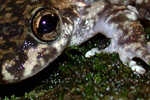
(05/28/2013) Over the past 30 years, amphibians worldwide have been infected with a lethal skin disease known as the amphibian chytrid fungus (Batrachochytrium dendrobatidis). “The disease can cause rapid mortality, with infected frogs of susceptible species dying within weeks of infection in the laboratory.” Jodi Rowley, a herpetologist with the Australian Museum told mongabay.com. “This disease has now been associated with declines and extinctions in hundreds of species of amphibians worldwide, and is a serious threat to global amphibian biodiversity.”

(04/22/2013) The misty mountains of the Western Ghats seem to unravel new secrets the more you explore it. Researchers have discovered two new frog genera, possibly restricted to rare and threatened freshwater swamps in the southern Western Ghats of India. The discoveries, described in the open-access journal Zootaxa, prove once again the importance of the mountain range as a biodiversity hotspot.

(04/10/2013) New Zealand’s Department of Conservation (DOC) is facing a backlash over plans to aerially drop a controversial poison, known as 1080, over the habitat of two endangered, prehistoric, and truly bizarre frog species, Archey’s and Hochsetter’s frogs, on Mount Moehau. Used in New Zealand to kill populations of invasive mammals, such as rats and the Australian long-tailed possum, 1080 has become an increasingly emotive issue in New Zealand, not just splitting the government and environmentalists, but environmental groups among themselves. Critics allege that the poison, for which there is no antidote, decimates local animals as well as invasives, while proponents say the drops are the best way to control invasive mammals that kill endangered species like birds and frogs and may spread bovine tuberculosis (TB).
Scientists discover 8 new frogs in one sanctuary, nearly all Critically Endangered (photos)
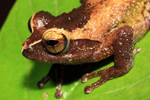
(03/21/2013) Two surveys in the mountainous forests of Sri Lank’s Peak Wilderness Sanctuary have uncovered eight new species of frogs, according to a massive new paper in the Journal of Threatened Taxa. While every year over a hundred new amphibians are discovered, eight new discoveries in a single park is especially notable. Sri Lanka is an amphibian-lovers paradise with well over 100 described species, most of which are endemic, i.e. found only on the small island country. Unfortunately the country has also seen more frog extinctions than anywhere else, and seven of the eight new species are already thought to be Critically Endangered.
Scientists clone extinct frog that births young from its mouth
(03/18/2013) Australian scientists have produced cloned embryos of an extinct species of frog known for its strange reproductive behavior, reports the University of New South Wales.
Captive frogs may be spreading diseases to wild cousins across Southeast Asia
(03/07/2013) Scientists have documented a series of links between exotic frogs for trade and diseases in wild frogs in Southeast Asia, including the first documented case of the chytrid fungus—a virulent and lethal disease—in Singapore. According to researchers writing in a new study in EcoHealth, frogs imported into Southeast Asia as pets, food, or traditional medicine are very likely spreading diseases to wild populations.
Starry frog rediscovered after thought extinct for 160 years (photos)
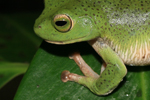
(03/07/2013) In 1853 Edward Frederick Kelaart, a physician and naturalist, collected a strange frog on the island of Sri Lanka then a British colony known as Ceylon. The specimen was a large shrub frog (about 2 inches or 5.5 centimeters long) with black-outlined white specks on lime-green skin. He dubbed it “starry” after its pale specks, but that was last anyone heard of it. Even the holotype—the body of the amphibian collected by Kelaart—went missing. Fast forward nearly 160 years—two world wars, Sri Lanka’s independence, and a man on the moon—when a recent expedition into Sri Lanka’s Peak Wilderness rediscovered a beguiling frog with pinkish specks.
Frogs radio-tracked for first time in Madagascar
![]()
(03/01/2013) Researchers have radio-tracked frogs for the first time in Madagascar. Attaching tiny radio transmitters weighing 0.3-0.35 grams (1/100 of an ounce) to 36 rainbow frogs (Scaphiophryne gottlebei), the research team tracked the movement of the colorful frogs through rugged canyons in Madagascar’s Isalo Massif. They found that the frogs have a short breeding period that occurs after the first intense rainfall at the start of the rainy season.
Popular pesticides kill frogs outright
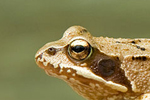
(01/28/2013) Commonly used agrochemicals (pesticides, fungicides and herbicides) kill frogs outright when sprayed on fields even when used at recommended dosages, according to new research in Scientific Reports. Testing seven chemicals on European common frogs (Rana temporaria), the scientists found that all of them were potentially lethal to amphibians. In fact, two fungicides—Headline and Captain Omya—wiped out the entire population of frogs at the recommended dosage. The study warns that agricultural chemicals could be having a large-scale and largely unrecorded impact on the world’s vanishing amphibians.